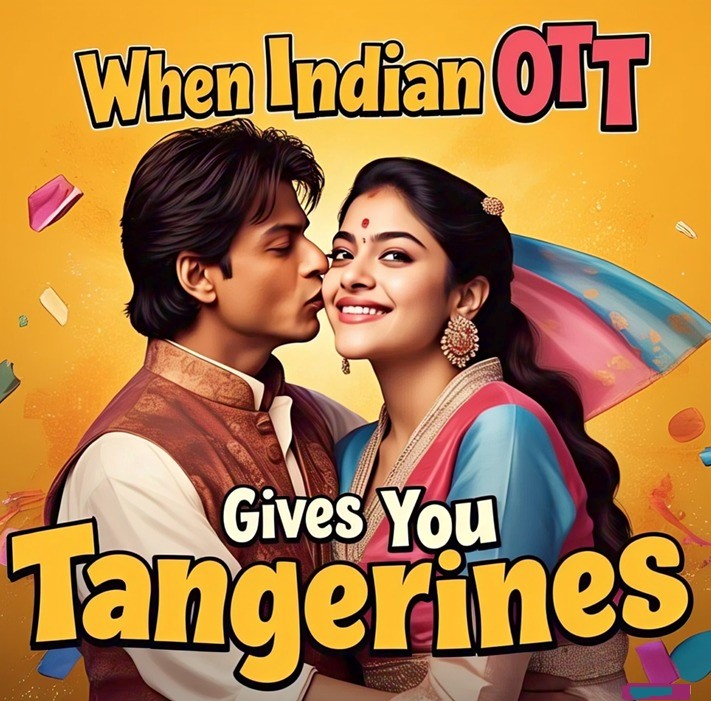What makes foreign content irresistible? The truth behind this ₹4.5 billion mystery will shock you

While 500 million Indians binge-watch Korean dramas to completion, they’re abandoning big-budget Hindi shows starring Bollywood superstars after just one episode. What makes foreign content irresistible but homegrown series unwatchable? The truth behind this ₹4.5 billion mystery will shock you.
India’s streaming market is booming. With about 57 OTT platforms competing for eyeballs and revenues expected to hit $4.5 billion this year. It is one of the world’s largest entertainment markets. JioHotstar alone boasts over 500 million active users, more than the entire population of the United States.
Yet there’s a troubling trend buried in the success story. While viewers binge-watch Korean dramas like “Squid Game”, “When Life Gives You Tangerines” and, even spirited over the top, dubbed South Indian films; they’re switching off Hindi original shows faster than ever.
Industry data reveals a stark reality: 6 out of 10 viewers who start watching Hindi original shows don’t finish them. Compare this to Korean dramas or South Indian content dubbed in Hindi, where 7 out of 10 viewers watch till the end.
The travesty is the OTT landscape has turned into a buffet with a cover charge. Viewers leaving shows right at the beginning, in a few minutes or even mid-way, appears to be high. Indeed, a towering red flag for Hindi ‘proclaimed originals’
Take Netflix’s “Bard of Blood,” produced by Shah Rukh Khan’s Red Chillies Entertainment. Despite the star power, it holds a modest 6.3 rating on IMDb and failed to generate sustained viewer interest. Meanwhile, “Squid Game” saw Indian viewership jump 370% in 2020.
The problem isn’t money or technology, it’s mindset. Most Hindi streaming shows are still being made by Bollywood producers who think like movie makers, not OTT series creators. “Who is the star?” is a quintessential question backed by an ecosystem that compels creators to align to a production company or even ‘sell out the concept’. OTT content creation is like this one big compromised family that is having fun at someone else’s expense.
The Bollywood Trap: Traditional film producers like Ekta Kapoor and Karan Johar dominate the streaming space, bringing cinema’s star-first approach to a medium that demands character-driven storytelling. Movies can rely on spectacle and star power for two hours, but web series need compelling narratives to keep viewers engaged across multiple episodes.
Success Stories Show the Way: When platforms bet on strong writers instead of big stars, magic happens. SonyLIV’s “Scam 1992” attracted 6 million viewers with its gripping storytelling. Amazon Prime’s “The Family Man” drew 16.8 million viewers in its second season. Netflix’s “Delhi Crime” even won an International Emmy. These rare shows succeeded because they prioritized storytelling over star casting.
The Korean Wave vs. Indian Content
Korean entertainment evidently has cracked the global code that Indian platforms are still searching for. Shows like “When Life Gives You Tangerines” (IMDb 9.2) have Indian viewers hooked, while homegrown Hindi content struggles. There are viewers watching them twice over in English and Hindi dubbed versions. These are Actors, Directors and Production houses that are completely alien to Indian viewers and yet massive super hits – that is ‘content’.
The difference lies in approach. Korean production houses invest heavily in writers’ rooms and character development. They treat each episode as a chapter in a larger story, not a standalone spectacle. South Indian content dubbed in Hindi also performs better than original Hindi shows. These films and series, rooted in strong regional storytelling traditions, account for 50% of ZEE5’s total viewership.
Money matters too. While Indian crews offer cost advantages, VFX work costs 30-50% less than global standards, Hindi originals typically have budgets of ₹10-50 crore. Compare this to international series that often spend $10 million per episode.
This budget gap shows in production quality. Indian technical crews, while skilled, often lack specialized training in digital storytelling techniques. Many successful Indian shows rely on international post-production support to meet global quality standards.
The game might be changing. Reliance Industries’ 2023 merger of Disney+ Hotstar and JioCinema created JioHotstar, valued at ₹23,000 crore. This consolidation puts unprecedented resources behind content creation.
Data Goldmine: With about 500 million Jio telecom users, the company understands Indian viewing habits better than any competitor. This data helps predict what content will work.
Deep Pockets: Reliance’s ₹19.95 lakh crore market cap means it can compete with global platforms on budget. The company has already committed ₹120 crore to original programming.
Scale Advantage: JioHotstar’s IPL streaming rights drew 61.2 million concurrent viewers for the 2025 final, proving its technical capability and reach.
Strategic Shift: Unlike traditional Bollywood producers, Reliance is partnering with proven content creators like Hansal Mehta, signalling a move toward writer-centric development.
The Path Forward
Industry experts suggest several solutions to fix the Hindi content problem:
Writer-First Approach: Successful platforms globally prioritize narrative development over star power. Indian platforms need to follow suit. Discouraging ‘middle men’ and ‘Creative Directors’ that facilitate disparaging practices.
Technical Upskilling: India’s AVGC (Animation, Visual Effects, Gaming, Comics) Task Force is working to train crews in digital storytelling techniques.
Hybrid Production: Combining Indian cost efficiency with global post-production expertise could bridge the quality gap.
Data-Driven Decisions: Using analytics to understand viewer preferences can reduce the hit-or-miss nature of content creation.
Story first Approach: Create direct and open channels of communication with creators, create an eco-system to encourage ‘story telling’, arrest rampant corrupt practices and support the narrative.
The Billion-Dollar Question
India’s streaming market has all the ingredients for success: massive audience, linguistic diversity, cost-effective production, and growing disposable income. The success of international and regional content on Indian platforms proves viewers are ready for quality entertainment.
The challenge is execution. Can Indian platforms, led by giants like JioHotstar, break free from outdated production mindsets and create Hindi content that resonates globally?
Korean entertainment went from local to global sensation in two decades. India, with its vast resources and audience base, could potentially achieve the same transformation. But it requires treating streaming content as a distinct art form, not just cinema chopped into episodes.
The next few years will determine whether India’s streaming boom translates into a global content revolution, or remains a missed opportunity in the world’s largest entertainment market. My bet is on Reliance to transform the eco-system as they have done in the telecom backbone of content. Whether Reliance’s JioHotstar has its ears to the ground, is for time to tell.


